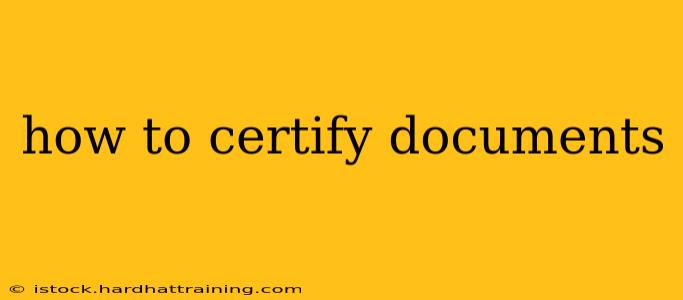Certifying documents is a crucial process for various legal, administrative, and personal reasons. Whether you need to verify a copy for a job application, submit legal paperwork, or prove the authenticity of a document for immigration purposes, understanding the process is vital. This guide will walk you through the different methods and considerations involved in certifying documents effectively.
What Does it Mean to Certify a Document?
Document certification confirms a document's authenticity and accuracy. It verifies that the document is a true and correct copy of the original or that the information contained within is genuine. The process typically involves a designated authority, such as a notary public, commissioner of oaths, or other authorized personnel, attesting to the document's legitimacy.
Different Types of Document Certification
The specific method for certifying a document varies depending on its purpose and the required level of verification. Here are some common scenarios:
1. Certified True Copy:
This is the most common type of certification. It confirms that a copy of a document is an exact replica of the original. A certifying officer will compare the copy to the original, ensuring there are no alterations or discrepancies. They will then sign and stamp the copy, indicating their verification.
2. Notarized Documents:
Notarization is a more formal process, typically used for legal documents. A notary public confirms the signer's identity and witnesses their signature. The notary then affixes their official seal and signature to the document, adding a layer of legal validity. Notarization is frequently required for deeds, affidavits, and other legal instruments.
3. Certified Translations:
When dealing with documents in foreign languages, a certified translation is necessary. This involves a professional translator verifying the accuracy of the translated document. The translator will then sign and stamp the translation, confirming its fidelity to the original document.
4. Apostille Certification:
For international use, an apostille is a certificate that authenticates the seal or signature of a public official. It verifies the authority of the certifying officer within their jurisdiction, making the document acceptable in countries that are members of the Hague Convention.
Steps to Certify a Document
The exact steps involved in certifying a document vary based on the type of certification needed and the location. However, some general steps are often involved:
- Gather Necessary Documents: This includes the original document and any supporting identification.
- Find a Certifying Authority: Identify the appropriate official authorized to certify documents in your area. This could be a notary public, commissioner of oaths, or other designated official.
- Prepare the Document: Ensure the document is clear, legible, and complete. You may need to provide multiple copies depending on requirements.
- Present Documents and Identification: You will typically need to present the original document, a copy for certification, and your valid photo identification to the certifying authority.
- Witness the Certification: The certifying officer will compare the copy to the original and verify its accuracy. They will then sign and stamp the certified copy.
- Pay Fees: There are usually associated fees for document certification.
Choosing the Right Certification Method
Selecting the appropriate method depends on the document's purpose and its intended use. Always check the specific requirements of the institution or organization receiving the document. If unsure, contacting them directly is recommended to avoid delays or rejection.
Common Questions Regarding Document Certification:
- What types of identification are accepted? This varies by jurisdiction but commonly includes driver's licenses, passports, and national identity cards.
- How long is a certified document valid? The validity depends on the document and the certifying authority; some certifications might have an expiration date.
- Can I certify a document myself? Generally no; impartial certification requires an authorized third party.
This comprehensive guide provides a framework for understanding document certification. Remember to always verify the specific requirements for your situation and consult with the relevant authorities for detailed instructions. By following these steps, you can ensure your documents are properly certified and accepted for their intended purpose.
